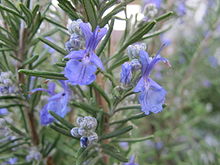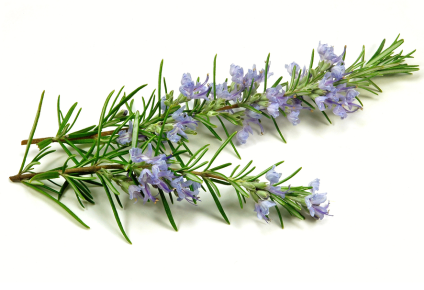
Rosemary bush in flower
General Plant Information:
Rosemary is native to the Mediterranean region and Caucasus. There are three major species of rosemary, and they are all native to the Mediterranean region. Where their homes overlap, they create hybrids of the varying species. Rosemary is an evergreen perennial shrub. They can have full sun exposure and are drought tolerant. In the United States, they are found naturally in Alabama, but can be grown in majority of places.
Identifiable Characteristics:
The plant has needle-like evergreen leaves that are recognizable by their strong aroma. They have flowers that are light purple and have long protruding stamens. Their fragrant flowers and leaves attract bees, butterflies and birds.
Traditional Uses:
Historically, rosemary has been seen in folklore with a purpose of aiding memory. In Spain, Rosemary was used as a defense against witchcraft and menaces. Superstitious travelers would not leave home without their rosemary. Straining from Greek mythology and Christian theology, rosemary also represents the purity of women. This is because both Aphrodite and The Virgin Mary had iconic images with rosemary draped over them. There is a warning to men to avoid destroying rosemary because he will not be able to find relief from his woman’s rule. Rosemary was also seen in Shakespeare’s famous, Hamlet and Romeo and Juliet respectively,
“There’s rosemary, that’s for remembrance. Pray you, love, remember!”
“Dry up your tears, and stick your Rosemary on this dry corse.”
-Shakespeare
Because of the idea that rosemary helps memory, it has been used in funerals and weddings as a symbol of remembrance. It is common for a bride to incorporate rosemary into their bouquet. This represents fidelity, love, friendship, and remembering the life the woman lived prior to marriage.
Rosemary’s benefits are diverse, ranging from medical phenomena to its relaxing smell and beauty. Over the years, scientific research has proven that rosemary inhibits the release of certain enzymes linked to neurological disorders that cause memory loss. Rosmarinic acid has very strong antioxidant, antibacterial, and antifungal properties. This can aid headaches, colds, nervous diseases (such as depression), relieves asthma, relaxes the muscles of the gastrointestinal tract, and may increase blood flow to the heart. It has also been thought to promote hair growth for people with alopecia. Their smell, beauty, and adaptability to environments make them appealing to gardeners. The rosemary plant also attracts bees, birds and butterflies, which can be beneficial to all of the plants in a garden.
Modern Day Uses:
Rosemary leaves and flowers are commonly used for culinary flavoring, medicine, and beauty products. The leaves and flowers can be left as is or dried, to then be used as a cooking ingredient or as tea. With respect to cooking, rosemary is particularly popular in Mediterranean cuisine. The bitter taste is thought to go well with fatty foods and meats. The plants also have medicinal benefits. To create rosemary oil, the leaves and flowers are pressed. This can then be taken orally or applied topically. The medicinal uses include alleviating muscle pain, improving memory, promoting hair growth, and boosting the immune and circulatory system. It adds beauty and character to the border of gardens. The rosemary oil is commonly added to beauty or grooming products. Rosemary oil is commonly seen in perfumes, soaps, shampoos, and lotions because of its refreshing smell and benefits with hair growth.
Important Chemicals:
Important vitamins found in rosemary are iron, calcium and vitamin B6. The plant is also rich in antioxidants and carnosic acid which causes it to neutralize harmful particles (free radicals) in the body. The neutralization of these harmful particles allows rosemary to be correlated to enhancing memory, concentration and protection of the brain against aging. The chemicals that cause majority of the benefits of rosemary are secondary metabolites, carnosic acid and carnsol. The element of these chemicals that is advantageous is the polyphenol.
Dangers:
Although this plant is seen to have many benefits, there has also been evidence that it can be potent and toxic. It is noted that it should be avoided by women who are pregnant or breastfeeding. Rosemary oil can cause conflicting effects, including seizures, when taken internally, and has the potential to irritate skin when applied externally.
Current Research:
Rosemary has been one of the most studied herbs. The effects of the chemicals of rosemary have been explored and tested in-vitro and animal models. It has been found to be exceptionally beneficial because of its unique chemicals carnosic acid and carnsol. These are both secondary metabolites which have expressed favorable characteristics such as anti-inflammatory, anti-proliferative, antimicrobial, anti-cancer, and fighting against neurological and metabolic disorders. There has been links that rosemary can help decrease the risks related to obesity, diabetes, and metabolic syndrome. The polyphenols present in the plant is the main contributor to these attributes. Polyphenols can be split into two more specific groups: phenolic acids and phenolic diterpenes. This research has been a great starting point for scientists to work on uncovering a design of new functional foods that may help consumers with neurological disorders, metabolic syndrome, obesity, and maybe even cancer. However, there is still much research that needs to be done, specifically looking at rosemary in a broader sense. Scientists need to confirm how rosemary’s chemicals would react to its breakdown during digestion and metabolism and how they would react with the gut microbiome. It is also important for scientists to find concentrations that are safe for humans (Sanchez- Camargo and Herrero, 2017).
Over recent years, the amount of research done on rosemary has concentrated on its antibacterial properties. One specific study researched this because rosemary was a common remedy for various diseases, including microbial infections. The conclusion of this research was that there rosemary contains chemicals that give its essential oils antibacterial and anti fungal properties (Khoury, Stein, Epavier, et al., 2016).
This antibacterial properties have been explored to benefit other parts of the body as well, such as the mouth. Essential oils containing rosemary have been found successful in preventing diseases associated with oral bacterial. The chemicals that were found to be the most successful against harmful bacteria were menthol and eugenol, which are both present in rosemary. (Freires, I.A., Denny, C., Benso, B., et al., 2015)

Sources:
Sanchez-Camargo, A.d.P. and M. Herrero. 2017. Rosemary (Rosmarinus officinalis) as a functional ingredient: recent scientific evidence. Current Opinion in Food Science 14: 13-19.
Freires, I.A., Denny, C., Benso, B., et al., 2015. Antibacterial Activity of Essential Oils and Their Isolated Constituents against Cariogenic Bacteria: A Systematic Review. Molecules 44: 7329-58.
Khoury, M., Stien, D., Eparvier V., et. al. 2016. Report on the Medicinal Use of Eleven Lamiaceae Species in Lebanon and Rationalization of Their Antimicrobial Potential by Examination of the Chemical Composition and Antimicrobial Activity of Their Essential Oils. Evid Based Complement Alternat Med 10:1155.
https://www.ncbi.nlm.nih.gov/pubmed/28053641
https://www.ncbi.nlm.nih.gov/pubmed/25911964
http://powo.science.kew.org/taxon/urn:lsid:ipni.org:names:455509-1
http://www.missouribotanicalgarden.org/PlantFinder/PlantFinderDetails.aspx?kempercode=b968
http://www.medicalnewstoday.com/articles/266370.php
http://www.adlunamlabs.com/History_of_Rosemary.html
Page created by Madeline Maruska


